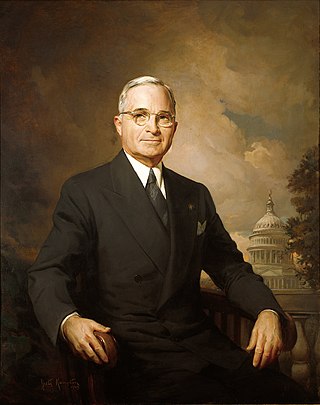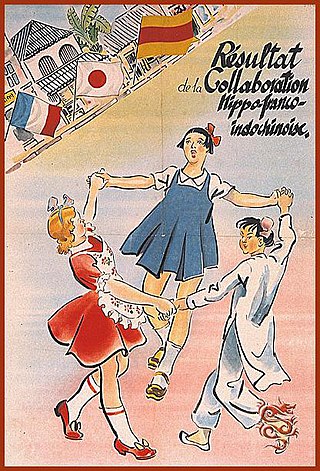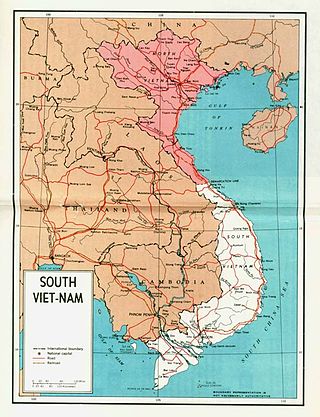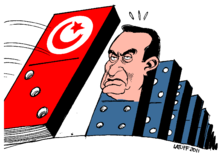
Hồ Chí Minh, colloquially known as Uncle Ho or just Uncle (Bác), and by other aliases and sobriquets, was a Vietnamese communist revolutionary, nationalist, and politician. He served as prime minister of the Democratic Republic of Vietnam from 1945 to 1955 and as president from 1945 until his death, in 1969. Ideologically a Marxist–Leninist, he was the Chairman and First Secretary of the Workers' Party of Vietnam, the predecessor of the current Communist Party of Vietnam.

The Truman Doctrine is an American foreign policy that pledges American "support for democracies against authoritarian threats." The doctrine originated with the primary goal of countering the growth of the Soviet bloc during the Cold War. It was announced to Congress by President Harry S. Truman on March 12, 1947, and further developed on July 4, 1948, when he pledged to oppose the communist rebellions in Greece and Soviet demands from Turkey. More generally, the Truman Doctrine implied American support for other nations threatened by Moscow. It led to the formation of NATO in 1949. Historians often use Truman's speech to Congress on March 12, 1947 to date the start of the Cold War.

The bamboo curtain is a Cold War political demarcation between the communist states of East Asia, particularly the People's Republic of China, and the capitalist states of East, South, and Southeast Asia. To the north and northwest lay the communist states of China, the Soviet Union, North Vietnam, North Korea, and the Mongolian People's Republic. To the south and east lay the capitalist and non-communist countries of India, Pakistan, Japan, Indonesia, Malaysia, Singapore, the Philippines, Thailand, Taiwan, South Korea, Hong Kong, and Macau. Before the Indochina Wars the non-communist bloc included French Indochina and its successor states South Vietnam, Laos, and Cambodia. However, after the wars the new countries of Vietnam, Laos, and Democratic Kampuchea became communist states. In particular, following the Korean War, the Korean Demilitarized Zone became an important symbol of this Asian division.

The First Indochina War was fought between France and Việt Minh, and their respective allies, from 19 December 1946 until 20 July 1954. Việt Minh was led by Võ Nguyên Giáp and Hồ Chí Minh. Most of the fighting took place in Tonkin in Northern Vietnam, although the conflict engulfed the entire country and also extended into the neighboring French Indochina protectorates of Laos and Cambodia.

George Frost Kennan was an American diplomat and historian. He was best known as an advocate of a policy of containment of Soviet expansion during the Cold War. He lectured widely and wrote scholarly histories of the relations between the USSR and the United States. He was also one of the group of foreign policy elders known as "The Wise Men".

Containment was a geopolitical strategic foreign policy pursued by the United States during the Cold War to prevent the spread of communism after the end of World War II. The name was loosely related to the term cordon sanitaire, which was containment of the Soviet Union in the interwar period.

The Mutual Defense Assistance Act was a United States Act of Congress signed by President Harry S. Truman on 6 October 1949. For U.S. foreign policy, it was the first U.S. military foreign aid legislation of the Cold War era, and initially to Europe. The Act followed Truman's signing of the Economic Cooperation Act, on April 3, 1948, which provided non-military, economic reconstruction and development aid to Europe.

The Geneva Conference was a conference that was intended to settle outstanding issues resulting from the Korean War and the First Indochina War and involved several nations. It took place in Geneva, Switzerland, from 26 April to 20 July 1954. The part of the conference on the Korean question ended without adopting any declarations or proposals and so is generally considered less relevant. On the other hand, the Geneva Accords that dealt with the dismantling of French Indochina proved to have long-lasting repercussions. The crumbling of the French colonial empire in Southeast Asia led to the formation of the states of the Democratic Republic of Vietnam, the State of Vietnam, the Kingdom of Cambodia, and the Kingdom of Laos. Three agreements about French Indochina, covering Cambodia, Laos, and Vietnam, were signed on 21 July 1954 and took effect two days later.

The Southeast Asia Treaty Organization (SEATO) was an international organization for collective defense in Southeast Asia created by the Southeast Asia Collective Defense Treaty signed in September 1954 in Manila, Philippines. The formal institution of SEATO was established on 19 February 1955 at a meeting of treaty partners in Bangkok, Thailand. The organization's headquarters was also in Bangkok. Eight members joined the organization.
The Indochina Wars were a series of wars which were waged in Indochina from 1945 to 1991, by communist forces against the opponents. The term "Indochina" referred to former French Indochina, which included the current states of Vietnam, Laos, and Cambodia. In current usage, it applies largely to a geographic region, rather than to a political area. The wars included:

Formal relations between the United States and Vietnam were initiated in the nineteenth century under former American president Andrew Jackson, but relations soured after the United States refused to protect the Kingdom of Vietnam from a French invasion.

Relations between Vietnam and China had been extensive for a couple of millennia, with Northern Vietnam especially under heavy Sinosphere influence during historical times. Despite their Sinospheric and socialist background, centuries of conquest by modern China's imperial predecessor as well as modern-day tensions have made relations wary. The People's Republic of China (PRC) ruled by the Chinese Communist Party (CCP) assisted North Vietnam and the Communist Party of Vietnam (CPV) during the Vietnam War whilst the Taiwan-based Republic of China (ROC) was allied with South Vietnam.

North Vietnam, officially the Democratic Republic of Vietnam, was a socialist state in Southeast Asia that existed from 1945 to 1976, with formal sovereignty being fully recognized in 1954. A member of the Eastern Bloc, it opposed the French-backed State of Vietnam and later the Western-allied Republic of Vietnam. North Vietnam emerged victorious over South Vietnam in 1975 and ceased to exist the following year when it unified with the south to become the current Socialist Republic of Vietnam.

After World War II and the collapse of Vietnam's monarchy, France attempted to re-establish its colonial rule but was ultimately defeated in the First Indo-China War. The Geneva Accords in 1954 partitioned the country temporarily in two with a promise of democratic elections in 1956 to reunite the country. The United States and South Vietnam insisted on United Nations supervision of any election to prevent fraud, which the Soviet Union and North Vietnam refused. North and South Vietnam therefore remained divided until the Vietnam War ended with the Fall of Saigon in 1975.

In mid-1940, Nazi Germany rapidly defeated the French Third Republic, and the colonial administration of French Indochina passed to the French State. Many concessions were granted to the Empire of Japan, such as the use of ports, airfields, and railroads. Japanese troops first entered parts of Indochina in September 1940, and by July 1941 Japan had extended its control over the whole of French Indochina. The United States, concerned by Japanese expansion, started putting embargoes on exports of steel and oil to Japan from July 1940. The desire to escape these embargoes and to become self-sufficient in resources ultimately contributed to Japan's decision to attack on December 7, 1941, the British Empire and simultaneously the USA. This led to the USA declaring war against Japan on December 8, 1941. The US then joined the side of the British Empire, at war with Germany since 1939, and its existing allies in the fight against the Axis powers.
The quagmire theory explains the cause of the United States involvement in the Vietnam War. The quagmire theory suggests that American leaders had unintentionally and mistakenly led the country into the Vietnam War. The theory is categorized as an "orthodox" interpretation of the Vietnam War.

When 1954 began, the French had been fighting the insurgent communist-dominated Viet Minh for more than seven years attempting to retain control of their colony Vietnam. Domestic support for the war by the population of France had declined. The United States was concerned and worried that a French military defeat in Vietnam would result in the spread of communism to all the countries of Southeast Asia—the domino theory—and was looking for means of aiding the French without committing American troops to the war.

1947–1950 in French Indochina focuses on events influencing the eventual decision for military intervention by the United States in the First Indochina War. In 1947, France still ruled Indochina as a colonial power, conceding little real political power to Vietnamese nationalists. French Indochina was divided into five protectorates: Cambodia, Laos, Tonkin, Annam, and Cochinchina. The latter three made up Vietnam.
The Vietnam War was a major event that shaped the course of the world in the second half of the 20th century. Although it was a regional conflict that occurred on the Indochinese Peninsula, it also affected the strategic interests of the People's Republic of China, the United States and the Soviet Union as well as the relations between these great powers. China, in particular, also played an important role in the Vietnam wars starting from the First Indochina War. China militarily supported North Vietnam by fighting South Vietnam and the United States in the Vietnam War, as well as providing extensive logistical, training, and material aid.

The Cold War in Asia was a major dimension of the worldwide Cold War that shaped diplomacy and warfare from the mid-1940s to 1991. The main countries involved were the United States, the Soviet Union, China, North Korea, South Korea, North Vietnam, South Vietnam, Cambodia, Afghanistan, Iran, Iraq, India, Bangladesh, Pakistan, Indonesia, and Taiwan. In the late 1950s, divisions between China and the Soviet Union deepened, culminating in the Sino-Soviet split, and the two then vied for control of communist movements across the world, especially in Asia.




















